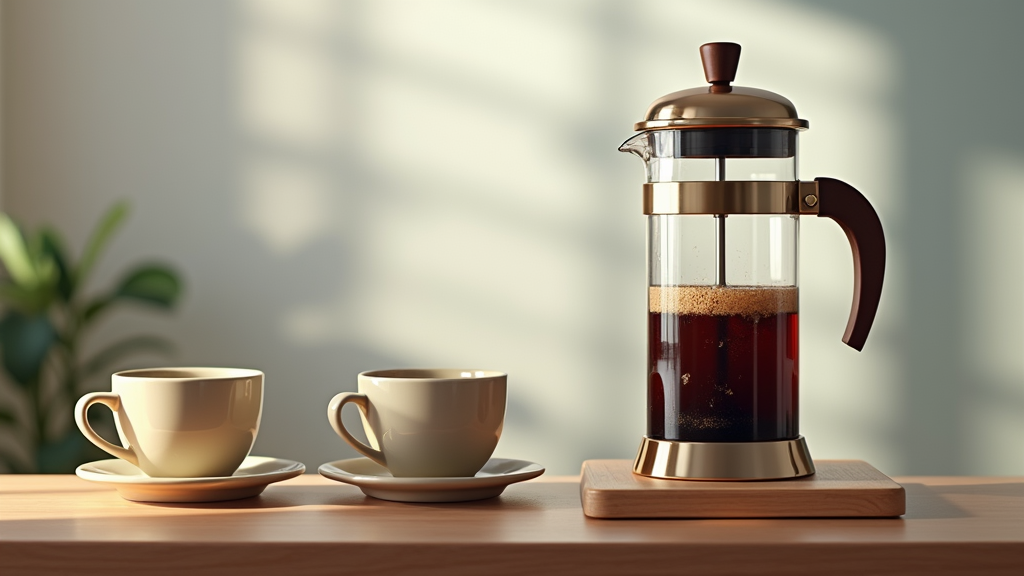Table of Contents
- Introduction
- Understanding the Aeropress
- Understanding the French Press
- Aeropress vs. French Press: A Side-by-Side Comparison
- Conclusion
Introduction

The Battle of the Brews: Aeropress vs. French Press
In the ever-evolving world of coffee, two brewing methods consistently rise to the top, captivating coffee enthusiasts with their unique approaches and distinct results: the Aeropress and the French Press. Both are celebrated for their simplicity and ability to produce exceptional coffee, yet they differ significantly in their brewing styles, ultimately leading to vastly different flavor profiles. This article dives deep into the heart of these two titans, exploring their origins, dissecting their processes, and ultimately helping you decide which brewer deserves a place on your countertop.
Brief History and Evolution
The Aeropress, a relative newcomer to the coffee scene, has taken the specialty coffee world by storm. Born in Palo Alto, California, this innovative device was invented in approximately 2005, quickly gaining popularity for its versatility and ability to produce a clean, concentrated brew. Its rise has been meteoric, fueled by its ease of use and the passionate community that has sprung up around it.
In stark contrast, the French Press boasts a rich history that spans over eight decades. Originating in Milan, Italy, this classic brewing method has stood the test of time, remaining a beloved choice for coffee lovers worldwide. Its enduring appeal lies in its simplicity and the full-bodied, sediment-rich coffee it produces, a testament to its time-honored design.
What You’ll Learn
By the end of this exploration, you’ll have a comprehensive understanding of the key differences between the Aeropress and the French Press. We’ll delve into the nuances of each brewing method, highlighting their respective strengths and weaknesses. We’ll also explore the pros and cons of each, empowering you to make an informed decision about which brewer best aligns with your individual preferences and brewing style. Whether you prioritize a quick, clean cup or a rich, immersive experience, this guide will equip you with the knowledge you need to navigate the exciting world of coffee brewing.
Understanding the Aeropress
What is an Aeropress?
The Aeropress is a manual coffee maker renowned for its ability to brew smooth, rich coffee using air pressure. Unlike drip coffee makers or French presses, the Aeropress uses a unique method of extraction: hot water is forced through coffee grounds via a plunger and a paper filter, resulting in a clean, sediment-free cup.
Key Features and Specifications
The Aeropress boasts a compact and lightweight design, making it a favorite among coffee enthusiasts. It stands approximately 5.5 inches tall and weighs a mere 6.3 ounces, making it incredibly portable.
There are two primary brewing methods associated with the Aeropress:
- Standard Method: This involves placing the Aeropress directly onto a mug, adding coffee grounds and hot water, stirring, and then pressing the plunger to extract the coffee.
- Inverted Method: A technique popularized by the coffee community, the inverted method involves assembling the Aeropress upside down, adding coffee grounds and hot water, stirring, letting it steep, and then flipping it onto a mug before pressing. This allows for a longer steeping time and more control over the brewing process.
The Aeropress is designed for single-serving brewing. It utilizes disposable paper filters, which contribute to its clean flavor profile. Constructed from BPA-free plastic, the Aeropress prioritizes safety and durability.
Advantages of the Aeropress
The Aeropress offers several distinct advantages that have contributed to its popularity. The use of a paper filter results in a clean and defined flavor profile, free from the sediment often found in French press coffee. Its flexible brewing methods allow for consistent results and experimentation, catering to individual preferences. The Aeropress’s portable and durable design makes it an ideal companion for travel, ensuring a great cup of coffee wherever you go. Furthermore, it is remarkably easy to clean, simplifying the brewing process.
Disadvantages of the Aeropress
Despite its many benefits, the Aeropress does have some limitations. Its single-serving design makes it challenging to brew multiple cups of coffee simultaneously. Achieving optimal results requires a degree of precision, and the pressing action can be physically demanding for some users. For beginners, the Aeropress might seem more complex compared to simpler methods like the French press, requiring a bit of a learning curve to master.
Understanding the French Press

**Expert Insight:** While French presses excel at delivering a rich, full-bodied coffee, be mindful of potential drawbacks. To minimize sediment and muddled flavors, use a coarse grind, avoid over-steeping, and consider using a paper filter insert for a cleaner cup.
What is a French Press?
The French press, also known as a cafetière, is a manual coffee maker that offers a simple yet effective way to brew coffee. It works by steeping coffee grounds directly in hot water, allowing for a full-bodied extraction of flavors.
The brewing process involves adding coarsely ground coffee to the French press, pouring hot water over the grounds, and letting it steep for a few minutes. Once the steeping is complete, a mesh filter attached to a plunger is slowly pressed down, separating the coffee grounds from the brewed coffee. This method results in a rich and flavorful cup with a distinctive texture.
Key Features and Specifications
French presses come in various sizes and materials, but they share common features that define their functionality. A standard French press is approximately 7.5 inches tall and weighs around 17 ounces, although these dimensions can vary depending on the model and capacity.
Serving sizes also differ, with many models designed to brew multiple cups of coffee at once. Common capacities include 34 oz and 51 oz, making the French press ideal for serving small groups. The filter is typically made of metal or nylon mesh, designed to trap coffee grounds while allowing the flavorful oils and solubles to pass through. Materials used in construction range from glass and stainless steel to ceramic, each offering different aesthetic and durability qualities.
- Dimensions: Approximately 7.5 inches tall, weighs around 17 ounces (size varies)
- Serving Size: Multiple cups (capacity varies by model, e.g., 34 oz, 51 oz)
- Filter Type: Metal or nylon mesh filter
- Material: Glass, stainless steel, or ceramic
Advantages of the French Press
One of the main advantages of using a French press is its convenience. It requires minimal preparation and no paper filters, making it an eco-friendly option. The French press is particularly favored for its ability to produce bold, rich flavors, as the direct immersion method extracts more oils and compounds from the coffee grounds.
The French press is also excellent for brewing coffee for larger groups, thanks to its multi-cup capacity. Users often find that the French press provides consistent results with fewer adjustments needed compared to other brewing methods, making it a reliable choice for daily coffee preparation.
Disadvantages of the French Press
Despite its many benefits, the French press has some drawbacks. One common issue is the potential for muddled flavors and a higher level of sediment in the final cup. This is due to the mesh filter, which, while effective, doesn’t catch all the fine particles.
There are also health concerns associated with the coffee oils that pass through the filter, as they may contribute to increased cholesterol levels in some individuals. Additionally, the cleaning process for a French press can be more intensive compared to other coffee makers like the Aeropress. Disassembling and thoroughly cleaning the components is essential to prevent residue buildup and maintain optimal performance.
Aeropress vs. French Press: A Side-by-Side Comparison
Flavor Profile
When it comes to flavor, the Aeropress and French Press offer distinctly different experiences. The Aeropress is known for producing a clean, bright cup of coffee, allowing well-defined flavor notes to shine through. The use of a paper filter in the Aeropress brewing process helps to remove oils and sediment, resulting in a smoother, less murky flavor profile. If you appreciate clarity and nuance in your coffee, the Aeropress might be your preferred method.
In contrast, the French Press delivers a full-bodied, rich, and bold cup of coffee. Because the French Press uses a metal filter, it allows more of the coffee’s natural oils and sediment to pass through into the final brew. This contributes to a heavier mouthfeel and a more intense flavor experience. However, some may find the sediment undesirable, while others appreciate the added depth and complexity it brings.
Brewing Time
Speed is another area where the Aeropress and French Press differ. The Aeropress boasts a quick preparation time, typically ranging from just 1 to 3 minutes. This includes the time it takes to press the coffee through the filter. The fast brewing time is one of the reasons the Aeropress is a favorite among those who want a quality cup of coffee without a long wait.
The French Press, on the other hand, requires a steeping time of 3 to 5 minutes to properly extract the coffee’s flavors. Add to this the time it takes to heat the water and prepare the press, and the total brewing time can be a bit longer than with the Aeropress. While the extra time may result in a richer flavor, it’s something to consider if you’re looking for a quick caffeine fix.
Portability
If you’re a coffee lover who enjoys brewing on the go, the Aeropress is an excellent choice. Its compact and lightweight design makes it incredibly portable and easy to pack in a bag or suitcase. Whether you’re camping, traveling, or simply heading to the office, the Aeropress allows you to enjoy a quality cup of coffee anywhere.
The French Press, being larger and often made of glass, is less suitable for travel. Its size and fragility make it more difficult to pack and more susceptible to damage. While some smaller, more durable French Press options are available, they still don’t quite match the portability of the Aeropress.
Ease of Use
The Aeropress, while relatively simple, requires some technique and practice to master. Factors like the grind size, water temperature, and pressing technique can all impact the final flavor of the coffee. While it’s not overly complicated, it may take a few tries to dial in your preferred brewing method.
The French Press is known for its simple and straightforward brewing process, making it an excellent choice for beginners. Simply add coffee grounds and hot water, let it steep, and press the plunger down. The French Press is a forgiving brewing method that consistently delivers a decent cup of coffee, even for those new to manual brewing.
Cleaning
When it comes to cleaning, the Aeropress shines. The spent coffee grounds and filter are easily ejected into the trash with a simple push of the plunger. A quick rinse of the Aeropress chamber, and you’re done. The cleaning process is quick, easy, and mess-free.
Cleaning a French Press is a bit more involved. The spent coffee grounds need to be scooped out and discarded, and the mesh filter requires thorough rinsing to remove any remaining coffee particles. While not overly difficult, the cleaning process is definitely more time-consuming and messier than with the Aeropress.
Cost
Both the Aeropress and French Press are relatively affordable brewing options. The Aeropress typically retails for around $30-$40, making it a budget-friendly choice for coffee enthusiasts.
The price of a French Press can vary depending on the size, material, and brand. You can find basic French Presses for as little as $20, while larger, more premium models can cost upwards of $100. Ultimately, the cost will depend on your individual needs and preferences.
Conclusion

Which Brewer is Right for You?
Choosing between the AeroPress and the French Press ultimately boils down to personal preference. Are you typically brewing for just yourself, or do you often need to make coffee for multiple people? The AeroPress excels at brewing single, concentrated servings, while the French Press is better suited for brewing larger batches to share.
Taste also plays a crucial role. If you prefer a cleaner, brighter cup with minimal sediment, the AeroPress is the way to go. Its paper filter traps oils and micro-grounds, resulting in a smoother taste. On the other hand, if you enjoy a bolder, richer flavor with a heavier body, the French Press, with its metal filter allowing more oils and sediment into the final brew, will likely be more satisfying.
Consider convenience as well. The AeroPress is lightweight and portable, making it an excellent choice for travel or camping. It’s also relatively easy to clean. The French Press, while less portable, offers simplicity in its brewing process. There are no filters to replace, and the cleanup is straightforward.
Final Recommendation
Ideally, owning both an AeroPress and a French Press provides the most comprehensive coffee experience. Each brewer offers unique strengths and caters to different preferences, allowing you to enjoy a diverse range of coffee flavors and brewing styles.
The AeroPress is perfect for those seeking a quick, clean, and portable brewing method, while the French Press is ideal for those who appreciate a rich, full-bodied cup and enjoy the communal aspect of sharing coffee. Both are relatively inexpensive and durable, making them worthy additions to any coffee aficionado’s collection.

